Roughly a quarter of U.S. adults (27%) regularly watch religious services online or on TV, while a third regularly attend services in person, according to a Pew Research Center survey conducted in November 2022. The survey took place as the coronavirus pandemic was winding down but before the Centers for Disease Control and Prevention declared an end to the COVID-19 public health emergency in the United States in May 2023.
In this report, “regular watchers” of religious services include everyone who says they watched services online or on TV in the month prior to the survey or that they generally watch at least once or twice a month. “Regular attenders” include everyone who says they attended services in person in the month prior to the survey or that they generally attend at least once or twice a month.
There is a fair amount of overlap between those who go to religious services in person and those who join virtually: 17% of U.S. adults say they do both. Accounting for this overlap, the survey finds that about four-in-ten Americans (43%) regularly join in worship services one way or the other, either in person or on screens – a figure that has held steady since the pandemic hit the U.S. in early 2020.
Among the 17% of Americans who both attend services in person and watch them virtually, the clear preference is attending in person. Roughly three-quarters of those who worship both ways say they prefer going to services in person, while about one-in-ten prefer virtual services and 14% have no preference.
In general, Americans who go in person to a church, synagogue, mosque, temple or other house of worship feel more connected to their fellow worshippers. About two-thirds (65%) of regular attenders say they feel “a great deal” or “quite a bit” of connection with others who attend in person. That’s more than twice the share of virtual worshippers who say they feel those levels of connection with people who physically attend the services they are watching (28%) and nearly three times the share of virtual worshippers who feel strongly connected to other people who – like themselves – are watching the services on screens (22%).
The survey also finds that about four-in-ten adults who regularly watch services online or on TV (39%) say that while they are watching, they do the things they normally would do if they were attending in person, such as praying or responding out loud, singing or kneeling. Overall, 25% of virtual viewers say they feel like an active participant in the services they watch. The remaining three-quarters either feel like they are watching without truly being an active participant (32%) or feel “a little of both” ways (42%).
On the other hand, most viewers see advantages in watching virtually. Of six possible reasons listed in the survey for joining religious services remotely, the top choice is convenience; 43% of people who regularly watch services online or on TV say convenience is a major reason they do so, and 31% say convenience is a minor reason. Respondents could choose multiple reasons, and other common choices are being able to watch services that are held far away from where they live, and being able to watch services without worrying about catching or spreading COVID-19 or other illnesses. Fewer say they have an illness or disability that prevents them from attending in person, that their congregation meets online only (with no in-person option), or that watching provides a way for them to keep up with a house of worship they used to belong to.
This chapter also explores other elements of watching religious services on screens, including how satisfied virtual worshippers are with the experience; whether U.S. adults tend to watch services at congregations other than the ones they attend in person; how many different congregations they join virtually; and whether the services they watch are inside or outside the area where they live.
What share of U.S. adults watch or attend religious services?
To measure the presence of U.S. adults at religious services, Pew Research Center asked two sets of questions. First, we asked Americans whether they attended or watched services in the last month. Second, we asked how often, in general, they attend or watch services.
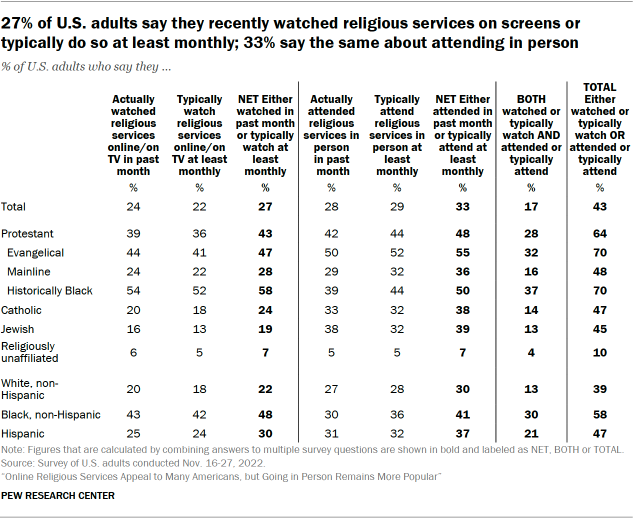
Putting these figures together, 33% of Americans either say they generally attend services in person at least once a month or say they went to services in the month prior to the survey. Another 27% say they generally watch services online or on TV at least monthly or report that they did so in the month prior to the survey. This includes 17% of U.S. adults who partake in religious services both ways, attending physically and virtually. In sum, 43% of Americans indicate they were watching and/or attending religious services on a regular basis at the time of the survey in November 2022.
When did regular virtual viewers of religious services begin the habit?
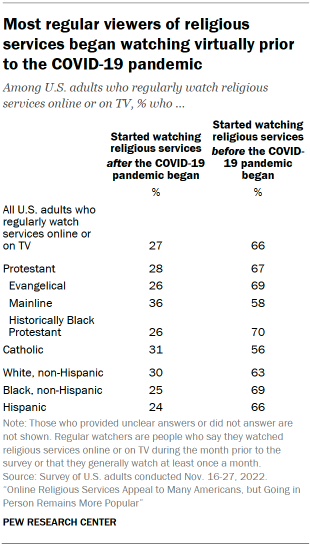
To get a broad sense of how long Americans have been streaming religious services, the survey asked when they started this habit: Was it during the COVID-19 pandemic? Or before the pandemic began?
Most regular viewers (66%) say they began watching services on screens before the pandemic. About a quarter say they started doing so during the pandemic. (The remainder either gave an inconsistent pattern of responses or declined to answer the question.)
However, it may be helpful to bear in mind that as the pandemic recedes, the percentage of Americans going to religious services in person has risen, while the share joining online or on TV has fallen. Since this question was asked only of people who currently watch religious services on screens, it does not capture substantial numbers who were watching services on screens during the height of the pandemic but no longer did so by the time the survey was conducted in November 2022 – a group that may have been more inclined to adopt the habit during the pandemic. A Center survey in July 2020 found that a third of U.S. adults had watched religious services online or on TV in the previous month, and a little more than half of them said they did so for the first time during the pandemic.
Most common reasons for virtual viewing
The survey also asked regular viewers of religious services about their reasons for watching remotely. People in this group (27% of U.S. adults) were presented with six possible reasons and were asked whether each was a “major reason,” a “minor reason,” or “not a reason” why they choose to watch religious services virtually.
The most common reason Americans give for watching services online or on TV is simply that “it is convenient,” with 43% of regular viewers citing this as a major reason and an additional 31% describing it as a minor reason. Six-in-ten remote viewers cite the ability to watch services that are held far away from where they live, including about a third (34%) who say this is a major reason why they watch services virtually.
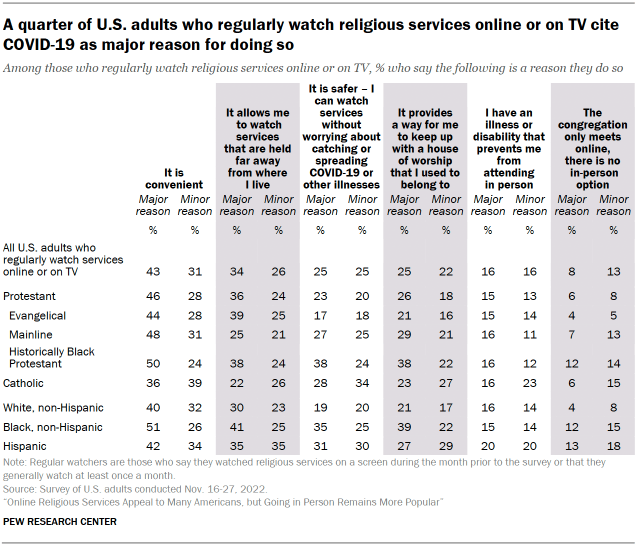
About half of all virtual viewers say that being able to worship without worrying about catching or spreading COVID-19 or other illnesses is a reason, including a quarter who describe this concern as a major incentive for watching religious services online or on TV. Similar numbers say it provides a way for them to keep up with a house of worship they used to belong to. Smaller shares say a disability or illness prevents them from attending services in person – about a third say this is either a major or minor reason – or say their congregation only offers virtual services.
Regular viewers who belong to historically Black Protestant denominations are more likely than those in any other major U.S. religious group to cite safety from contagious diseases; 38% say it is a major reason why they choose to worship remotely. Members of historically Black Protestant churches and evangelical Protestants also are especially likely to say they watch virtually because it allows them to see services far away from where they live.
The virtual worship experience
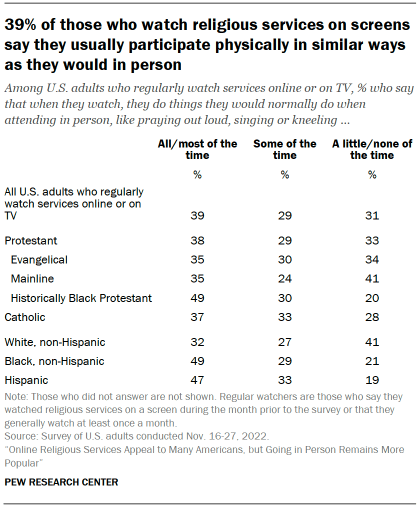
Another gauge of the virtual worship experience is whether Americans physically participate in the same ways they would if they were present in person. The survey asked regular watchers of religious services how often during virtual services “do you do the things you would normally do if you were attending the service in person, like praying out loud, saying responses out loud, singing or kneeling?” About four-in-ten regular religious service viewers (39%) say they do such things “all the time” or “most of the time” while watching services.
Members of churches in the historically Black Protestant tradition are more likely than other Christian groups to report engaging in these activities all or most of the time when they watch services virtually.
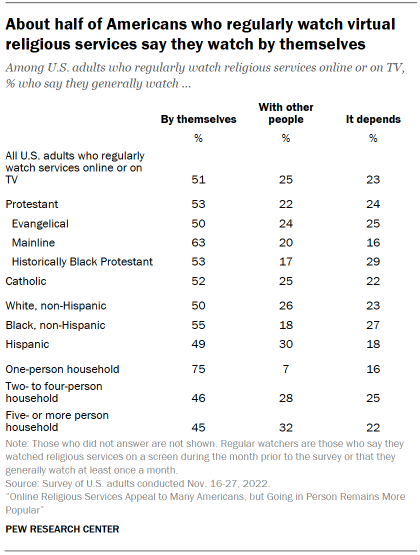
Yet many members of historically Black Protestant churches who stream religious services online or watch on TV do so alone (53%), which is also the case for virtual worshippers as a whole. About half (51%) of U.S. adults who regularly watch religious services online or on TV say they watch by themselves. A quarter of virtual worshippers say they generally watch with other people, while 23% say “it depends.” Mainline Protestants are somewhat more likely than members of other Christian subgroups to say they watch virtual services by themselves (63%).
Do watchers of religious services feel like active participants?
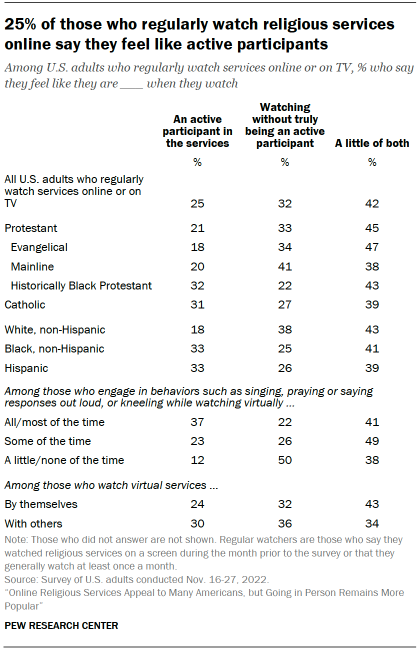
A quarter of U.S. adults who regularly watch religious services online or on TV say that when they watch, they feel they are an active participant in the services, while slightly more (32%) say they watch without feeling they are “truly” being an active participant. Meanwhile, a plurality (42%) say that they feel a little bit of both ways while watching services on screens.
Protestants in the historically Black tradition (32%) and Catholics (31%) who regularly watch services online or on TV are more likely than evangelical Protestants (18%) and mainline Protestants (20%) to say they feel they are actively participating when they watch. Additionally, regular viewers who are White (18%) are less likely than those who are Black or Hispanic (33% each) to report feeling this way while watching services.
Virtual worshippers who report doing the things they normally would do at services in person – like praying or responding aloud, singing or kneeling – are more likely to feel like active participants than those who don’t engage in those kinds of behaviors.
Satisfaction with virtual services
About two-thirds of U.S. adults who regularly watch religious services online or on TV say they are generally “extremely” or “very” satisfied with these services. Nearly three-in-ten virtual worshippers (28%) say they are “somewhat” satisfied with the services they watch, and 5% say they are “not too” or “not at all” satisfied.
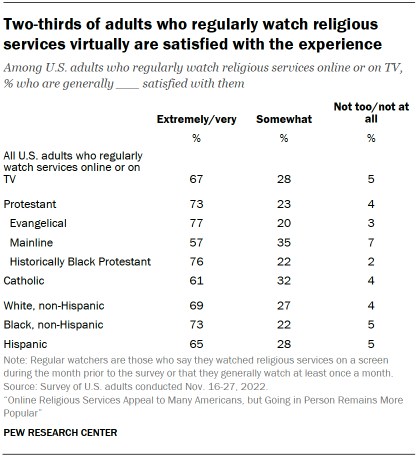
About three-quarters of evangelicals (77%) and Protestants in historically Black denominations (76%) who regularly watch religious services on screens report high levels of satisfaction with them, which is notably higher than the shares of mainline Protestant (57%) and Catholic (61%) viewers who say the same.
Satisfaction with sermons at virtual religious services also tends to be high – though not as high as for sermons at the worship services Americans attend in person.
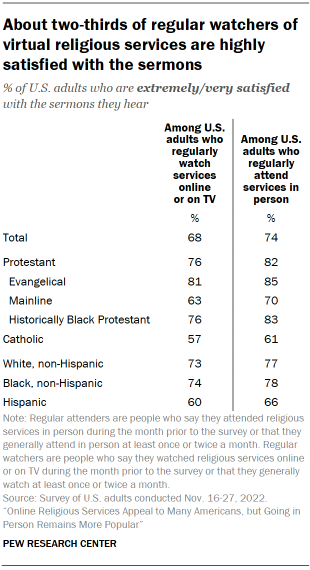
About two-thirds (68%) of virtual viewers say they are extremely or very satisfied with the sermons they hear online or on TV. This is slightly lower than the 74% of regular attenders who say they are extremely or very satisfied with the sermons they hear when they go to religious services in person.
Meanwhile, about eight-in-ten (81%) evangelicals who are regular viewers of virtual services report being highly satisfied with the sermons they hear, as do roughly three-quarters (76%) of viewers who affiliate with historically Black Protestant churches. Both groups are more likely than mainline Protestants (63%) and Catholics (57%) who regularly watch religious services online or on TV to say they are extremely or very satisfied with the sermons.
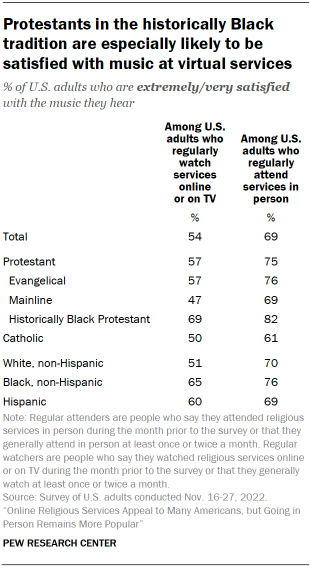
Looking at differences by race and ethnicity apart from religious affiliation, about three-quarters of both Black (74%) and White (73%) Americans who regularly watch services online or on TV say they are extremely or very satisfied with the sermons at these services. A smaller share of Hispanic adults in this group express a high level of satisfaction (60%).
In general, regular viewers are less satisfied with the music at virtual services than with the sermons. And the gap between satisfaction with music at virtual services and at services attended in person is larger than the corresponding gap on sermons. A little more than half of regular viewers (54%) say they are extremely or very satisfied with the music they hear when watching services online or on TV, compared with 69% of regular attenders who say this about the music at in-person services.
Among regular viewers, those in the historically Black Protestant tradition are most likely to say they are extremely or very satisfied with the music they hear online or on TV when watching religious services (69%). Smaller shares of evangelical Protestant (57%), Catholic (50%) and mainline Protestant (47%) viewers say the same. And irrespective of religious denomination, Black (65%) and Hispanic (60%) viewers are more likely than those who are White (51%) to say they are highly satisfied with the music at religious services online or on TV.
How connected do virtual viewers feel to other worshippers?
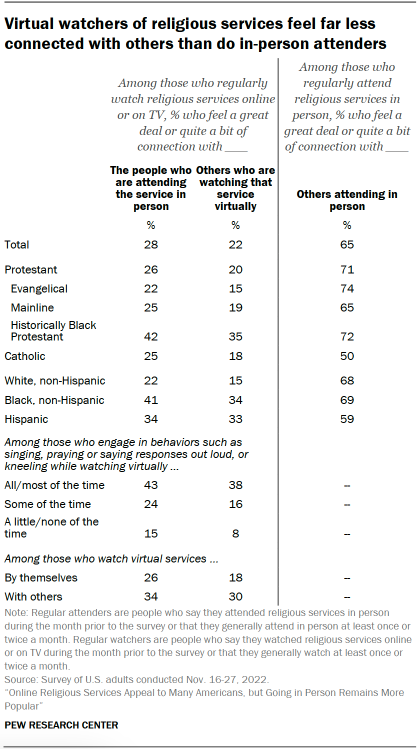
Respondents who regularly watch virtual services were asked to rate how connected they feel both with the people attending the same services in person and with those who, like themselves, are watching virtually. Separately, Americans who regularly attend services in person were asked to rate how connected they feel with others attending the services alongside them, physically.
Overall, 28% of people who regularly watch services online or on TV say they feel either “a great deal” (14%) or “quite a bit” (14%) of connection with people attending the same service in person; an additional 22% say they feel “some” connection, and 44% say they feel “a little” or “no” connection.
Meanwhile, among regular viewers, smaller numbers express a strong connection (i.e., a great deal or quite a bit) with other worshippers who are also watching the service virtually. Regular viewers who belong to churches in the historically Black Protestant tradition are more likely than those in other Christian groups to say they feel strong levels of connection to in-person attendees and to others watching on screens. For example, 42% of these viewers say they feel a strong connection to the people attending a service in person while they themselves are watching virtually, compared with 25% of Catholics, 25% of mainline Protestants and 22% of evangelicals who say this.
In addition, viewers who typically do things like praying out loud, singing or kneeling while watching services are more likely than those who don’t do these things to say they feel strong connections with other watchers and with people attending the service physically. Viewers who watch services with others, rather than by themselves, are also more likely to feel connected to other virtual worshippers and to those worshipping at the same services in person.
In general, adults who regularly attend services in person report much stronger feelings of connection to other worshippers than those who view services virtually do. Roughly two-thirds of regular attenders say they feel a great deal (35%) or quite a bit (30%) of connection with the other people in attendance. Protestant attenders (71%) are much more likely than those who are Catholic (50%) to report feeling this level of connection with their fellow churchgoers.
Clear preference for in-person services among those who also watch virtually
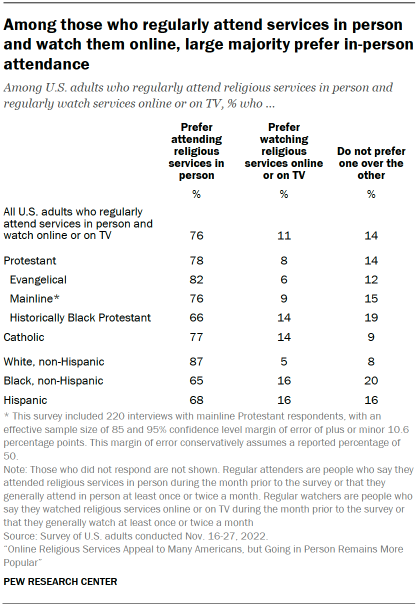
Among U.S. adults who both watch services online or on TV and attend them in person on a regular basis, there is no ambiguity about which mode of worship they prefer. Roughly three-quarters (76%) say they prefer attending in person, while about one-in-ten (11%) say they prefer online services. An additional 14% say that they have no preference.
Large majorities of every religious group with large enough sample sizes for analysis say they prefer attending services in person to watching them virtually, though members of historically Black Protestant denominations are somewhat less likely than evangelicals and Catholics to say this.
Leaving religious denomination aside to consider differences by race and ethnicity only, roughly two-thirds of Hispanic (68%) and Black (65%) Americans who both physically attend and watch services online on a regular basis say they prefer attending services in person. The two groups are equally likely (16% each) to say they prefer watching services on screens. White Americans are much more likely to prefer in-person attendance (87%) and less likely to prefer watching virtually (5%).
How many different congregations do virtual worshippers watch?
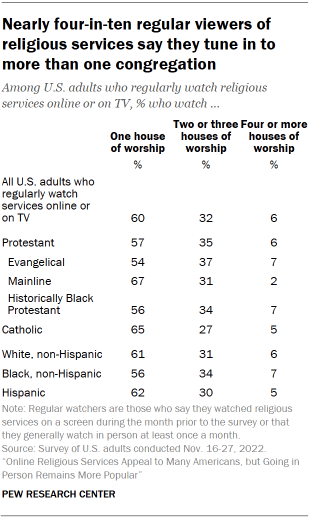
Overall, a majority of U.S. adults who regularly watch religious services online or on TV (60%) say they stream or tune in to the services of just one house of worship. About a third (32%) say they watch two or three congregations, and an additional 6% say they remotely watch the services of four or more congregations.
Some religious groups are more likely than others to say they watch services offered by multiple congregations. Among regular viewers, evangelical Protestants (45%) are more likely than mainline Protestants (33%) and Catholics (32%) to say they watch the services of two or more houses of worship.
Majority of virtual service viewers watch a non-local congregation
Nearly four-in-ten adults (38%) who regularly watch services online say the services they watch are offered by a house of worship in their local area. About a third (35%) say they watch services offered by a house of worship outside their local area, while a quarter say they watch services offered both by local and non-local congregations.
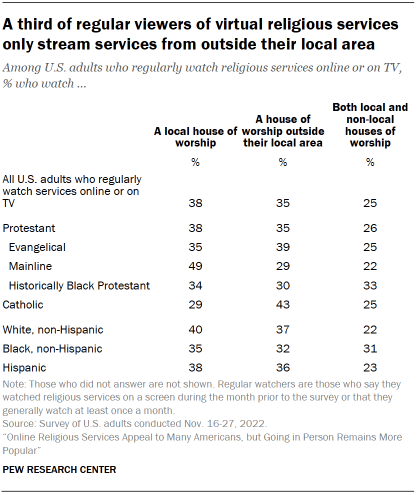
Among regular online viewers, mainline Protestants stand out as the group most likely to say they watch services only of local congregations in their area: About half (49%) say this. Regular virtual viewers who affiliate with denominations in the historically Black Protestant tradition are the most likely to watch services offered by both local and non-local houses of worship, with a third saying they do this.
Another way the survey explored viewership of religious services was by asking regular viewers whether they stream or tune in to virtual services only at their in-person congregation, or whether they watch services offered by other houses of worship.
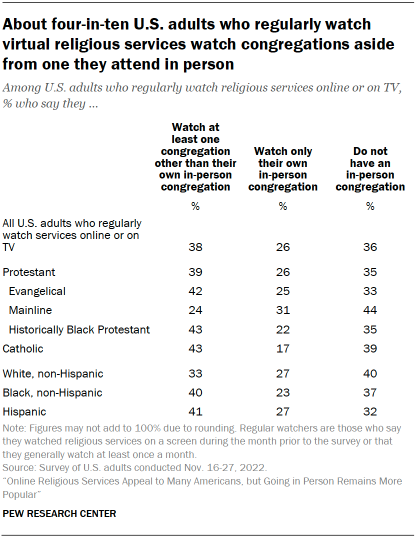
Nearly three-quarters of virtual viewers watch services at a congregation they do not attend in person. This includes those who watch at least one congregation other than the one they attend most often in person (38% of virtual viewers) as well as those who do not have an in-person congregation (36%). Both of those figures are higher than the 26% of virtual viewers who watch services only of their own, in-person congregation.
Roughly four-in-ten regular viewers who are Catholic (43%), belong to the historically Black Protestant tradition (43%), or are evangelical Protestants (42%) say they regularly attend services in person and also watch services of at least one congregation that is not their own. By comparison, a smaller number of mainline Protestant viewers (24%) say they do this.




